
Masovian Voivodeship or Mazowieckie Province or Mazowieckie Voivodeship or Mazovian Voivodeship or Mazovian Province, etc. is a voivodeship (province) in east-central Poland, containing Poland's capital Warsaw.
The Lechiticlanguages are a language subgroup consisting of Polish and several other languages and dialects that were once spoken in the area that is now Poland and eastern Germany. It is one of the branches of the larger West Slavic subgroup; the other branches of this subgroup are the Czech–Slovak languages and the Sorbian languages.

The Masurians or Mazurs, historically also known as Prussian Masurians, are an ethnic group originating from the region of Masuria, within the Warmian-Masurian Voivodeship, Poland. They number around 5,000–15,000 people. In the 2011 Polish census, 1,376 individuals declared themselves to be Masurian as either a first or a secondary identification. Before World War II and its post-war expulsions, Masurians used to be a more numerous ethnic group found in the southern parts of East Prussia for centuries following the 16th century Protestant Reformation. Today, most Masurians live in what is now Germany and elsewhere.
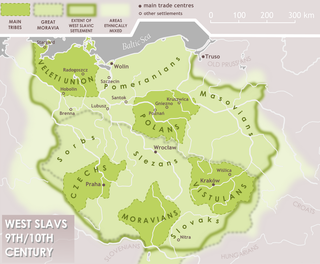
The Pomeranians, first mentioned as such in the 10th century, were a West Slavic tribe, which from the 5th to the 6th centuries had settled at the shore of the Baltic Sea between the mouths of the Oder and Vistula Rivers. They spoke the Pomeranian language that belonged to the Lechitic languages, a branch of the West Slavic language family.

Kuyavia, also referred to as Cuyavia, is a historical region in north-central Poland, situated on the left bank of Vistula, as well as east from Noteć River and Lake Gopło. It is divided into three traditional parts: north-western, central, and south-eastern.

The Polans, also known as Polanians or Western Polans were a West Slavic and Lechitic tribe, inhabiting the Warta River basin of the contemporary Greater Poland region starting in the 6th century. They were one of the main tribes in Central Europe and were closely related to the Vistulans, Masovians, Czechs and Slovaks.

Rawa Voivodeship was a unit of administrative division and local government in the Kingdom of Poland since 15th century until the partitions of Poland in 1795. It was part of the Greater Poland Province. Together with the Plock and Masovian Voivodeships it formed the former Duchy of Masovia.
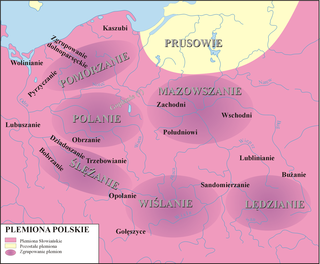
"Polish tribes" is a term used sometimes to describe the tribes of West Slavic Lechites that lived from around the mid-6th century in the territories that became Polish with the creation of the Polish state by the Piast dynasty. The territory on which they lived became a part of the first Polish state created by duke Mieszko I and expanded at the end of the 10th century, enlarged further by conquests of king Bolesław I at the beginning of the 11th century.
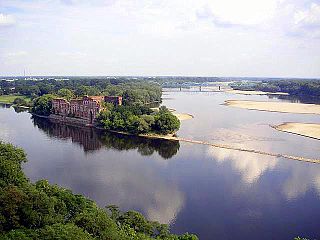
The Mazovian Lowland, also known as the Masovian Plain, is the largest geographical region in central Poland, roughly covering the historical region of Masovia. Sometimes it is also categorized as including Mazovian-Podlasian Lowlands which together form part of the greater North European Plain.
Lechites, also known as the Lechitic tribes, is a name given to certain West Slavic tribes who inhabited modern-day Poland and eastern Germany, and were speakers of the Lechitic languages. Distinct from the Czech–Slovak subgroup, they are the closest ancestors of ethnic Poles and of Pomeranians, Lusatians and Polabians.

Chełmno land is a part of the historical region of Pomerelia, located in central-northern Poland.
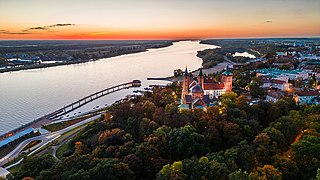
Mazovia or Masovia is a historical region in mid-north-eastern Poland. It spans the North European Plain, roughly between Łódź and Białystok, with Warsaw being the unofficial capital and largest city. Throughout the centuries, Mazovia developed a separate sub-culture featuring diverse folk songs, architecture, dress and traditions different from those of other Poles.
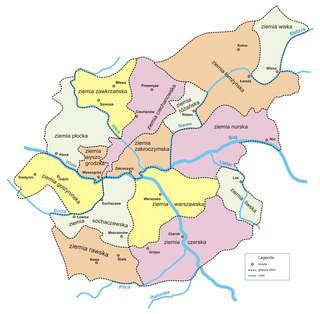
Czersk Land was an administrative unit (ziemia) of the Kingdom of Poland and the Polish–Lithuanian Commonwealth. With its capital in the town of Czersk, it belonged to the Masovian Voivodeship.

Ciechanów Land, named after the town of Ciechanów, located in central Poland, was an administrative unit (ziemia) of both the Kingdom of Poland and the Polish–Lithuanian Commonwealth. Divided into three counties, it belonged to the Masovian Voivodeship.

Greater Poland people is a collection of the ethnographic groups of Polish people, that originate from the region of Greater Poland.
The Borderlands Poles, also known as the Borderlands groups, is a term for the collection of the ethnographic groups of Polish people from the area of the Eastern Borderlands, an area to the east of modern borders of Poland, within the modern territory of Belarus, Lithuania, Ukraine. They are mostly descendants of Masovians, and to lesser extend, Lesser Poland people, who colonized the area across centuries. The groups aren't directly connected, having different origins, and developing separately. However, they are categorized together, due to the shared factor of devolving on the eastern boundaries of Polish population, influenced by the other ethnic groups located to the east. In the aftermath of World War II, they were displaced from the Soviet Union to Poland, mostly in the first repatriation of 1944–1946, and later in the second repatriation of 1955–1959. As such, they, and their descendants, now live across Poland. Such people are also known as the Bug River Poles.
The Bug River Poles are Polish people who, either were, or are descendants of, the inhabitants of the area of the Eastern Borderlands, an area to the east of modern borders of Poland, within the modern territory of Belarus, Lithuania, Ukraine, that were displaced from there to Poland between 1944 and 1959.

Łowiczans, also known as the Łowicz Dukes, is an ethnographic group of Polish people, that are part of the ethnographic subgroup of Masovians. They originate from the north west Masovia, located within borders of the Masovian Voivodeship, Poland. The group speak in the Łowicz subdialect of the Masovian dialect of Polish.
Poborzans, also spelled as Pobożans, are an ethnographic group of Polish people, that are part of the ethnographic subgroup of Masovians. They originate from the north west Masovia, located within the region of Poborze and Zawkrze, to the north of Mława river. The group is descendant of the Polish nobility that had inhabit the area in the Late Middle Ages. They are culturally separate from the neighbouring groups.

Sieradzans is an ethnographic group of Polish people that originate from the historical region of Sieradz Land, located within borders of the Łódź Voivodeship, Poland. The group does not express much cultural separateness from other Poles. Historically, the group has been heavily inflected by the neighboring groups of Silesians, Greater Poland people, and Lesser Poland people.















